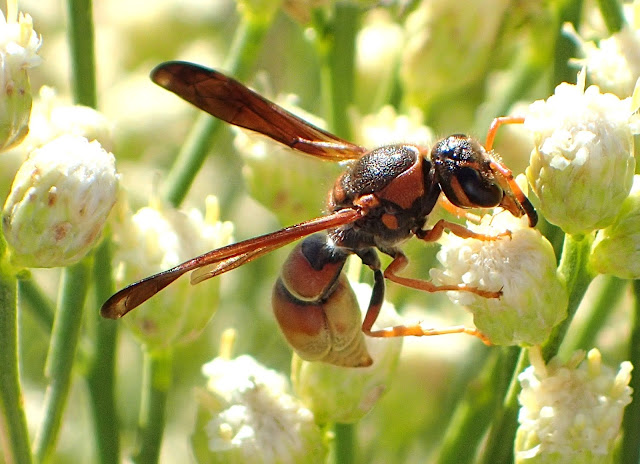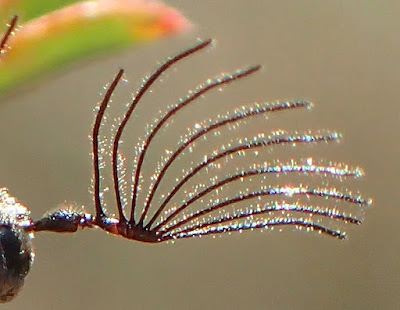October 2018 brought rain to the desert. While destructive hurricanes swept into Baja, Mexico, we enjoyed the load of precipitation in their aftermath , even if it came in the form of heavy hail in some places like Sonoita and our art show in Patagonia got quite slippery and muddy at times.
While the higher elevations of the sky islands and the Mogollon Rim received a sprinkling of snow and the cool nights are bringing fall colors to aspen and maples, our own low desert is again draped in fresh greens and on the foot hills of the sky islands all kinds of Asteraceae like Bidens erupted into millions of yellow flowers.
 Desert Broom is also blooming. Roads on the west side of the Santa Rita Mountains are lined with nice mature bushes of this often maligned species. It grows in disturbed habitats and insects and entomologists love it as much as gardeners seem to loath it.
Desert Broom is also blooming. Roads on the west side of the Santa Rita Mountains are lined with nice mature bushes of this often maligned species. It grows in disturbed habitats and insects and entomologists love it as much as gardeners seem to loath it. I am still primarily looking for beetles, but I did not find anything new, just the usual mix of Scarabs, Chrysomelids, Cerambycids, Ladybugs and Blister Beetles. I noticed a surprising absence of Cantharids. Maybe those flew early this year, I did see huge numbers in September
 |
| Sphaenothecus bilineatus, Disonycha glabrata (Pigweed Flea Beetle), Epicauta sp., Euphoria leucographa, Hippodamia convergens (Convergent Lady Beetle), Brephidium exile (Western Pygmy-Blue |
 |
| Atlides halesus (Great Purple Hairstreak |
Most Desert Broom bushes were dominated by wasps. Nests of Polistes comanchus, P. flavus and P. major castaneocolor must have been close by. Young queens and males were feeding on nectar (and pollen ?) . They are probably not raising larvae at this time of the year so it was all for their own consumption (not that the males ever contribute to feeding the brood). Many of the big young females were wrestling for dominance. Will their ranking still matter after they have survived the winter to start new colonies from scratch in spring?
 |
| Pepsis grossa and Tachypompilus unicolor |
The potter wasp Euodynerus guerrero gave a pretty good imitation of a paper wasp. Euodynerus probably has a sting of her own, but mimicking a powerful social wasps has its advantages.
The Pidgeon Horntail Tremex columba is a wood-boring wasp belonging to the Symphyta. Those wasps have no thin waist and no sting - their ovipositor is still just that. (The one in the picture is a male anyway) I found a rather big female and several smaller males.
They all were sitting quietly as if asleep. I have never seen these guys more active than this. Are they night active? Or can they be so slow because the trees they place their eggs in don't run away? One male flew very sluggishly after I disturbed him.
 |
| Oplomus dichrous |
 |
| Ptilophorus wrightii |
I concluded the nice day with checking up on my print and card inventory at gift shop of the Santa Rita Lodge in Madera Canyon and enjoyed coffee and ice cream watching Magnificent Hummingbirds.









